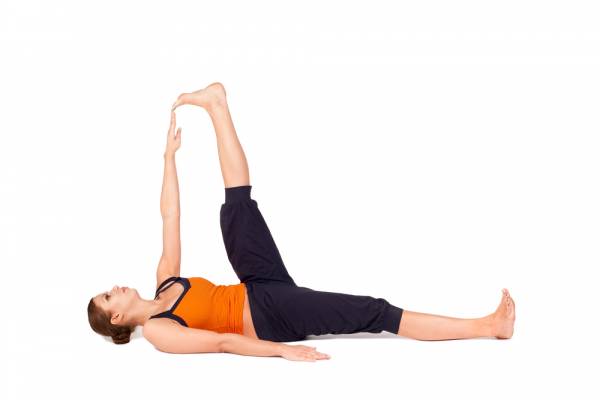Every single thing your body has ever done it remembers perfectly, even if you don’t. When I used to teach motorbike riding for the California Superbike School we spent a lot of time “clearing” people’s past crashes. While the terminology may have more to do with the senior riders all being Scientologists, there’s no other word I can think of to use.
Corners can obviously only ever go two ways – left or right – and most motorbike accidents are single vehicle accidents. This means the riders themselves are responsible for most of the crashes. There’s a fair chance as a rider that you’ll crash at some point and it’s probably going to be on a corner. If you crashed on a left-hand corner, and have no idea why, you will always be fearful of left-hand corners until you “clear” the reason why.
And at this point you’re probably wondering what in earth this has to do with stretching, right?
Your current limit of flexibility is a self-imposed point. When unconscious, we are all capable of full splits, yet when awake our bodies sense impending danger to the muscles lengthening beyond this preconceived point and begin to tense up to prevent injury. That stiffness you feel when you stretch is all in your head and totally created by you. At extreme ranges the opposite will happen and the muscles will go completely slack. This action – the removal of all tension – is to allow the muscle to be as loose as possible and avoid further injury.
About twelve years ago I tore my right hamstring off the bone while wrestling. I ended up in full splits, bent over my front leg with my opponent on top of me after I slipped trying to finish a single-leg takedown. In other words, I was as stretched out as I could get and had not just the speed of my fall to compound matters, but my opponent’s bodyweight on top of that. In this case my quads tightened up so much everyone thought my quads were damaged, but they had maxed out in an effort to take as much tension as possible out of the hamstring. The surgeon said he’d never seen anything quite like it apart from hit and run accidents.
As a result my right hamstring thinks that anytime I start to lengthen it something terrible is going to happen again. While there are plenty of people more flexible than I am, there are not too many who know as much about how to stretch a hamstring better than me. I’ve done it all – PNF, passive relaxed, isometric, resisted, dynamic, yoga, Primal Move, FMS – you name it and I’ve tried it all in the pursuit of just getting back to normal function (which was never being able to do full splits, for the record).
If you’ve got a serious previous injury such as I do you need to “clear” it with the body. Here’s how I do it:
The most important thing I need to do is convince my body that changing the length of the hamstring isn’t dangerous. This is the slowest part of the whole process and has taken as long as thirty minutes to work through in the past, although these days it takes about ten. I find a position where I am able to put the hamstring on stretch, without there being any kind of fear, and wait. For this to work you need to be in a comfortable position. A toe touch stretch will not work here, as the position is simply not one that can be performed from a relaxed state.
 I usually just lie on my back with my feet propped up against a wall, legs extended. To begin with I may be a foot away from the wall, but as my body begins to accept that the level of length I am asking for isn’t dangerous it slowly relaxes that vice-like tension in my right hamstring.
I usually just lie on my back with my feet propped up against a wall, legs extended. To begin with I may be a foot away from the wall, but as my body begins to accept that the level of length I am asking for isn’t dangerous it slowly relaxes that vice-like tension in my right hamstring.
Pavel Tsatsouline says in Relax Into Stretch, “If you paid attention, you have understood that what has been described is not the literal stretching of a relaxed muscle, but rather a patient waiting for the muscle to relax and picking up the slack.”
I stick with this until I can get my butt right up against the wall. At this point I have a ninety-degree bend at the waist and would score a three on the FMS Active Straight Leg Raise test. And now that my body has relaxed enough to allow this position, it’s time to stretch for real.
At this point I have two options. The first is to go and train having regained the lost movement needed to be able to get myself into the right position for most exercises. The second is to stretch for real, in an effort to gain flexibility. This second one is done so rarely by people these days – no one seems to have the time to stretch. Funnily enough they make the time once they get injured.
If I am now going to stretch to increase my flexibility there are two extra tools I use. The first is contract-relax stretching or what is commonly known as PNF (proprioceptive neuromuscular facilitation). This works through a sneaky little trick in the Renshaw cell of the spinal cord. During PNF stretches the stretch reflex is temporarily suppressed meaning the muscle won’t resist stretching as much as usual.
 PNF stretching works in a cycle like this – contract the muscle being stretched for a few seconds up to a few minutes, then relax it, and immediately stretch the same muscle further. Repeat for a few cycles until no further gains are made. At this point I usually return to a short period of relaxed stretching, waiting out the tension in my newly acquired position.
PNF stretching works in a cycle like this – contract the muscle being stretched for a few seconds up to a few minutes, then relax it, and immediately stretch the same muscle further. Repeat for a few cycles until no further gains are made. At this point I usually return to a short period of relaxed stretching, waiting out the tension in my newly acquired position.
There is some science to show that static stretching can reduce force output and perhaps in elite strength or power athletes this is true. I’m not sure I’m completely sold on that given every elite lifter I’ve watched train over the last few years has spent a huge amount of time on static stretching prior. But they finish their warm up with a large range of dynamic movements, so I do the same. If I’m about to train I will now spend time on dynamic flexibility and higher speed movements – all unloaded – before finally starting training for real. This takes the form of Primal Move, some light running drills and very light weight lifting.
I find as I get older that taking the time to warm up thoroughly, for twenty to thirty minutes each session, allows me to get my body moving correctly and prevent injury. Not surprisingly it also allows me to continue making some modest strength gains at forty despite the severity of previous injuries.
Be patient with the relaxed stretching and be relaxed when you do it – thirty minutes daily will work wonders for your body both in the short term and much longer term.
Photos courtesy of Shutterstock.






